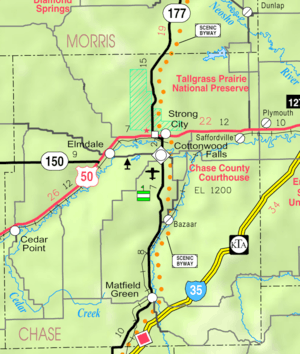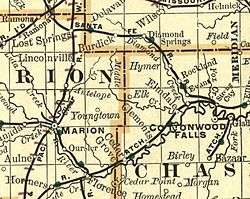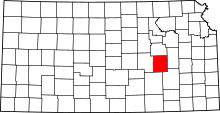Elmdale, Kansas
| Elmdale, Kansas | |
|---|---|
| City | |
|
Streets in Elmdale (2011) | |
 Location within Chase County and Kansas | |
 KDOT map of Chase County (legend) | |
| Coordinates: 38°22′23″N 96°38′46″W / 38.37306°N 96.64611°WCoordinates: 38°22′23″N 96°38′46″W / 38.37306°N 96.64611°W | |
| Country | United States |
| State | Kansas |
| County | Chase |
| Township | Diamond Creek |
| Government | |
| • Type | Mayor–Council |
| Area[1] | |
| • Total | 0.17 sq mi (0.44 km2) |
| • Land | 0.17 sq mi (0.44 km2) |
| • Water | 0 sq mi (0 km2) |
| Elevation | 1,198 ft (365 m) |
| Population (2010)[2] | |
| • Total | 55 |
| • Estimate (2015)[3] | 53 |
| • Density | 320/sq mi (130/km2) |
| Time zone | Central (CST) (UTC-6) |
| • Summer (DST) | CDT (UTC-5) |
| ZIP code | 66850 |
| Area code | 620 |
| FIPS code | 20-20675 [4] |
| GNIS feature ID | 0477256 [5] |
Elmdale is a city in Chase County, Kansas, United States. As of the 2010 census, the city population was 55.[6]
History

Early history
For many millennia, the Great Plains of North America was inhabited by nomadic Native Americans. From the 16th century to 18th century, the Kingdom of France claimed ownership of large parts of North America. In 1762, after the French and Indian War, France secretly ceded New France to Spain, per the Treaty of Fontainebleau.
19th century
In 1802, Spain returned most of the land to France. In 1803, most of the land for modern day Kansas was acquired by the United States from France as part of the 828,000 square mile Louisiana Purchase for 2.83 cents per acre.
In 1806, Zebulon Pike led the Pike expedition westward from St Louis, Missouri, of which part of their journey followed the Cottonwood River through Chase County near the current city of Elmdale.[7]
In 1854, the Kansas Territory was organized, then in 1861 Kansas became the 34th U.S. state. In 1859, Chase County was established within the Kansas Territory, which included the land for modern day Elmdale.
In 1871, the Atchison, Topeka and Santa Fe Railway built a main line east-west through Elmdale.[8] In 1996, it merged with Burlington Northern Railroad and renamed to the current BNSF Railway. Most locals still refer to this railroad as the "Santa Fe".
In 1873, a post was relocated from Middle Creek (an extinct town), to the rail community of Elmdale.[9]
20th century
Elmdale was incorporated in 1904.[10]
In 1916, Camp Wood YMCA was built about 1.5 miles south of Elmdale.[11][12]
There have been numerous floods during the history of Elmdale. In June and July 1951, due to heavy rains, rivers and streams flooded numerous cities in Kansas, including Elmdale. Many reservoirs and levees were built in Kansas as part of a response to the Great Flood of 1951. A levy was built and saved the town from numerous floods, but in 1998 a flood went over the levy.
In 1967, the high school closed, then later the grade school. All students currently attend schools in Cottonwood Falls.
Geography
Elmdale is located at 38°22′23″N 96°38′46″W / 38.37306°N 96.64611°W (38.372994, -96.645976),[13] in the scenic Flint Hills of the Great Plains. According to the United States Census Bureau, the city has a total area of 0.17 square miles (0.44 km2), all of it land.[1] The Cottonwood River is approximately 0.5 miles east of the city.
Climate
The climate in this area is characterized by hot, humid summers and generally mild to cool winters. According to the Köppen Climate Classification system, Elmdale has a humid subtropical climate, abbreviated "Cfa" on climate maps.[14]
Area attractions
Elmdale has one building on the National Register of Historic Places (NRHP).
Demographics
| Historical population | |||
|---|---|---|---|
| Census | Pop. | %± | |
| 1880 | 95 | — | |
| 1910 | 253 | — | |
| 1920 | 248 | −2.0% | |
| 1930 | 246 | −0.8% | |
| 1940 | 239 | −2.8% | |
| 1950 | 180 | −24.7% | |
| 1960 | 114 | −36.7% | |
| 1970 | 102 | −10.5% | |
| 1980 | 109 | 6.9% | |
| 1990 | 83 | −23.9% | |
| 2000 | 50 | −39.8% | |
| 2010 | 55 | 10.0% | |
| Est. 2015 | 53 | [3] | −3.6% |
| U.S. Decennial Census | |||
Elmdale is part of the Emporia Micropolitan Statistical Area.
2010 census
As of the census[2] of 2010, there were 55 people, 23 households, and 11 families residing in the city. The population density was 323.5 inhabitants per square mile (124.9/km2). There were 27 housing units at an average density of 158.8 per square mile (61.3/km2). The racial makeup of the city was 96.4% White and 3.6% from two or more races. Hispanic or Latino of any race were 9.1% of the population.
There were 23 households of which 26.1% had children under the age of 18 living with them, 39.1% were married couples living together, 4.3% had a female householder with no husband present, 4.3% had a male householder with no wife present, and 52.2% were non-families. 43.5% of all households were made up of individuals and 13% had someone living alone who was 65 years of age or older. The average household size was 2.39 and the average family size was 3.09.
The median age in the city was 45.3 years. 23.6% of residents were under the age of 18; 9.1% were between the ages of 18 and 24; 16.3% were from 25 to 44; 38.2% were from 45 to 64; and 12.7% were 65 years of age or older. The gender makeup of the city was 56.4% male and 43.6% female.
2000 census
As of the census[4] of 2000, there were 50 people, 25 households, and 11 families residing in the city. The population density was 300.9 people per square mile (113.6/km²). There were 36 housing units at an average density of 216.7 per square mile (81.8/km²). The racial makeup of the city was 100.00% White. Hispanic or Latino of any race were 4.00% of the population.
There were 25 households out of which 20.0% had children under the age of 18 living with them, 40.0% were married couples living together, and 56.0% were non-families. 48.0% of all households were made up of individuals and 20.0% had someone living alone who was 65 years of age or older. The average household size was 2.00 and the average family size was 2.91.
In the city the population was spread out with 20.0% under the age of 18, 6.0% from 18 to 24, 22.0% from 25 to 44, 34.0% from 45 to 64, and 18.0% who were 65 years of age or older. The median age was 47 years. For every 100 females there were 108.3 males. For every 100 females age 18 and over, there were 81.8 males.
As of 2000 the median income for a household in the city was $21,250, and the median income for a family was $22,250. Males had a median income of $22,917 versus $12,083 for females. The per capita income for the city was $13,083. There were no families and 19.2% of the population living below the poverty line, including no under eighteens and none of those over 64.
Government
The Elmdale consists of a mayor and five council members. The council meets the 1st Monday of each month at 7PM.[16]
Education
Primary and secondary education
Cottonwood Falls is part of Unified School District 284.[17][18] All students attend schools in Cottonwood Falls.
- Chase County Junior/Senior High School, 600 Main St in Cottonwood Falls.
- Chase County Elementary School, 410 Palmer St in Strong City.
Infrastructure
Transportation
U.S. Route 50 highway and BNSF Railway pass through the city.
Utilities
- Internet
- TV
- Satellite TV is provided by DirecTV, Dish Network.
- Free over-the-air ATSC digital TV.
See also
- National Register of Historic Places listings in Chase County, Kansas
- Cottonwood River and Great Flood of 1951
Further reading
References
- 1 2 "US Gazetteer files 2010". United States Census Bureau. Retrieved 2012-07-06.
- 1 2 "American FactFinder". United States Census Bureau. Retrieved 2012-07-06.
- 1 2 "Annual Estimates of the Resident Population for Incorporated Places: April 1, 2010 to July 1, 2015". Retrieved July 2, 2016.
- 1 2 "American FactFinder". United States Census Bureau. Retrieved 2008-01-31.
- ↑ "US Board on Geographic Names". United States Geological Survey. 2007-10-25. Retrieved 2008-01-31.
- ↑ "2010 City Population and Housing Occupancy Status". U.S. Census Bureau. Retrieved March 6, 2011.
- ↑ 1806 Pike Expedition map through Chase County.
- ↑ Santa Fe Rail History
- ↑ "Kansas Post Offices, 1828-1961 (archived)". Kansas Historical Society. Archived from the original on October 9, 2013. Retrieved 5 June 2014.
- ↑ Blackmar, Frank Wilson (1912). Kansas: A Cyclopedia of State History, Embracing Events, Institutions, Industries, Counties, Cities, Towns, Prominent Persons, Etc. Standard Publishing Company. p. 583.
- ↑ Camp Wood YMCA Information
- ↑ Camp Wood hopes to attract entire families for recreation, education; The Wichita Eagle; April 29, 2016.
- ↑ "US Gazetteer files: 2010, 2000, and 1990". United States Census Bureau. 2011-02-12. Retrieved 2011-04-23.
- ↑ Climate Summary for Elmdale, Kansas
- ↑ National Register of Historic Places - Clover Cliff Ranch House
- ↑ Elmdale - Directory of Public Officials
- ↑ USD 284
- ↑ Kansas School District Boundary Map
External links
| Wikimedia Commons has media related to Elmdale, Kansas. |
- City
- Schools
- USD 284, school district for all of Chase County.
- Historical
- Elmdale, A "Quiet" town of Chase County, Kansas, History and photographs.
- Historic Images of Elmdale, Special Photo Collections at Wichita State University Library.
- A Landmark And A Legend on YouTube, from Hatteberg's People on KAKE TV news
- Maps
- Elmdale City Map, KDOT
- Topo Map of Elmdale / Clements area, USGS
- Chase County Maps: Current, Historic, KDOT
.jpg)
